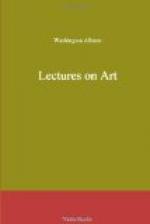heads to the stature please us better than six, or
why three or twelve heads seem to us monstrous.
If we say, in the latter case,
because the
head of the one is too small and of the other too
large, we give no
reason; we only state the
fact of their disagreeable effect on us.
And, if we make the proportion of eight heads our
rule, it is because of the fact of its being more
pleasing to us than any other; and, from the same feeling,
we prefer those statures which approach it the nearest.
Suppose we analyze a certain combination of sounds
and colors, so as to ascertain the exact relative
quantities of the one and the collocation of the other,
and then compare them. What possible resemblance
can the understanding perceive between these sounds
and colors? And yet a something within us responds
to both in a similar emotion. And so with a thousand
things, nay, with myriads of objects that have no other
affinity but with that mysterious harmony which began
with our being, which slept with our infancy, and
which their presence only seems to have
awakened.
If we cannot go back to our own childhood, we may
see its illustration in those about us who are now
emerging into that unsophisticated state. Look
at them in the fields, among the birds and flowers;
their happy faces speak the harmony within them:
the divine instrument, which these have touched, gives
them a joy which, perhaps, only childhood in its first
fresh consciousness can know. Yet what do they
understand of musical quantities, or of the theory
of colors?
And so with respect to Truth and Goodness; whose preexisting
Ideas, being in the living constituents of an immortal
spirit, need but the slightest breath of some outward
condition of the true and good,—a simple
problem, or a kind act,—to awake them, as
it were, from their unconscious sleep, and start them
for eternity.
We may venture to assert, that no philosopher, however
ingenious, could communicate to a child the abstract
idea of Right, had the latter nothing beyond or above
the understanding. He might, indeed, be taught,
like the inferior animals,—a dog, for instance,—that,
if he took certain forbidden things, he would be punished,
and thus do right through fear. Still he would
desire the forbidden thing, though belonging to another;
nor could he conceive why he should not appropriate
to himself, and thus allay his appetite, what was held
by another, could he do so undetected; nor attain
to any higher notion of right than that of the strongest.
But the child has something higher than the mere power
of apprehending consequences. The simplest exposition,
whether of right or wrong, even by an ignorant nurse,
is instantly responded to by something within him,
which, thus awakened, becomes to him a living voice
ever after; and the good and the true must thenceforth
answer its call, even though succeeding years would
fain overlay them with the suffocating crowds of evil
and falsehood.




